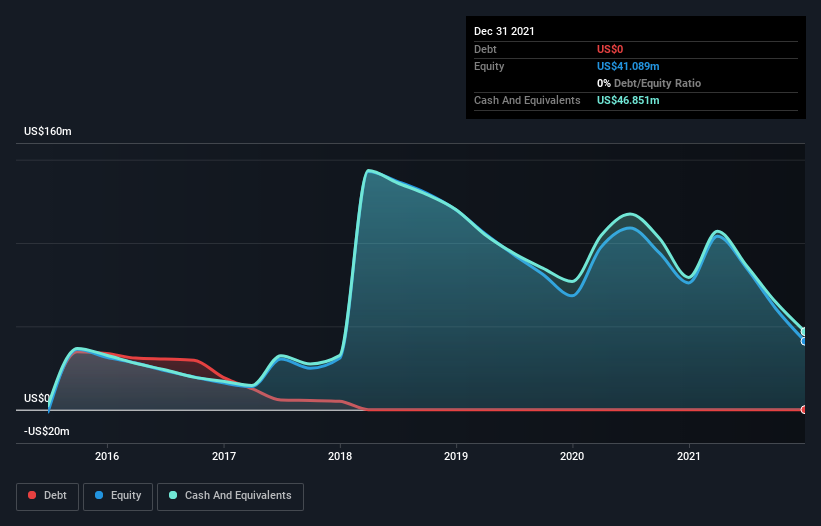Here's Why Catalyst Biosciences (NASDAQ:CBIO) Must Use Its Cash Wisely
We can readily understand why investors are attracted to unprofitable companies. For example, although software-as-a-service business Salesforce.com lost money for years while it grew recurring revenue, if you held shares since 2005, you'd have done very well indeed. But the harsh reality is that very many loss making companies burn through all their cash and go bankrupt.
Given this risk, we thought we'd take a look at whether Catalyst Biosciences (NASDAQ:CBIO) shareholders should be worried about its cash burn. For the purposes of this article, cash burn is the annual rate at which an unprofitable company spends cash to fund its growth; its negative free cash flow. The first step is to compare its cash burn with its cash reserves, to give us its 'cash runway'.
Check out our latest analysis for Catalyst Biosciences
Does Catalyst Biosciences Have A Long Cash Runway?
You can calculate a company's cash runway by dividing the amount of cash it has by the rate at which it is spending that cash. As at December 2021, Catalyst Biosciences had cash of US$47m and no debt. Looking at the last year, the company burnt through US$85m. Therefore, from December 2021 it had roughly 7 months of cash runway. That's quite a short cash runway, indicating the company must either reduce its annual cash burn or replenish its cash. However, if we extrapolate the company's recent cash burn trend, then it would have a longer cash run way. Depicted below, you can see how its cash holdings have changed over time.
How Well Is Catalyst Biosciences Growing?
Catalyst Biosciences actually ramped up its cash burn by a whopping 53% in the last year, which shows it is boosting investment in the business. That's pretty alarming given that operating revenue dropped 65% over the last year, though the business is likely attempting a strategic pivot. Considering these two factors together makes us nervous about the direction the company seems to be heading. While the past is always worth studying, it is the future that matters most of all. For that reason, it makes a lot of sense to take a look at our analyst forecasts for the company.
How Hard Would It Be For Catalyst Biosciences To Raise More Cash For Growth?
Since Catalyst Biosciences' revenue is down, and its cash burn is up, shareholders would quite reasonably be considering whether it can raise more money easily, if need be. Issuing new shares, or taking on debt, are the most common ways for a listed company to raise more money for its business. Many companies end up issuing new shares to fund future growth. By comparing a company's annual cash burn to its total market capitalisation, we can estimate roughly how many shares it would have to issue in order to run the company for another year (at the same burn rate).
Catalyst Biosciences' cash burn of US$85m is about 407% of its US$21m market capitalisation. Given just how high that expenditure is, relative to the company's market value, we think there's an elevated risk of funding distress, and we would be very nervous about holding the stock.
Is Catalyst Biosciences' Cash Burn A Worry?
There are no prizes for guessing that we think Catalyst Biosciences' cash burn is a bit of a worry. In particular, we think its cash burn relative to its market cap suggests it isn't in a good position to keep funding growth. While not as bad as its cash burn relative to its market cap, its increasing cash burn is also a concern, and considering everything mentioned above, we're struggling to find much to be optimistic about. The measures we've considered in this article lead us to believe its cash burn is actually quite concerning, and its weak cash position seems likely to cost shareholders one way or another. An in-depth examination of risks revealed 4 warning signs for Catalyst Biosciences that readers should think about before committing capital to this stock.
If you would prefer to check out another company with better fundamentals, then do not miss this free list of interesting companies, that have HIGH return on equity and low debt or this list of stocks which are all forecast to grow.
Have feedback on this article? Concerned about the content? Get in touch with us directly. Alternatively, email editorial-team (at) simplywallst.com.
This article by Simply Wall St is general in nature. We provide commentary based on historical data and analyst forecasts only using an unbiased methodology and our articles are not intended to be financial advice. It does not constitute a recommendation to buy or sell any stock, and does not take account of your objectives, or your financial situation. We aim to bring you long-term focused analysis driven by fundamental data. Note that our analysis may not factor in the latest price-sensitive company announcements or qualitative material. Simply Wall St has no position in any stocks mentioned.

 Yahoo Finance
Yahoo Finance 
